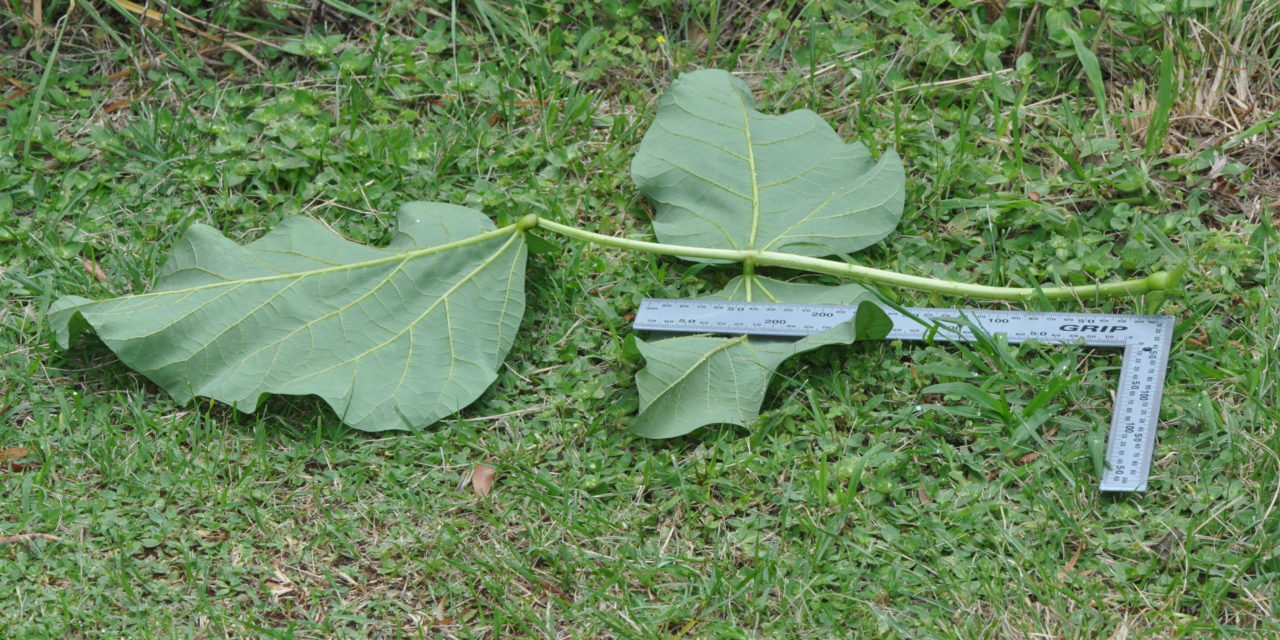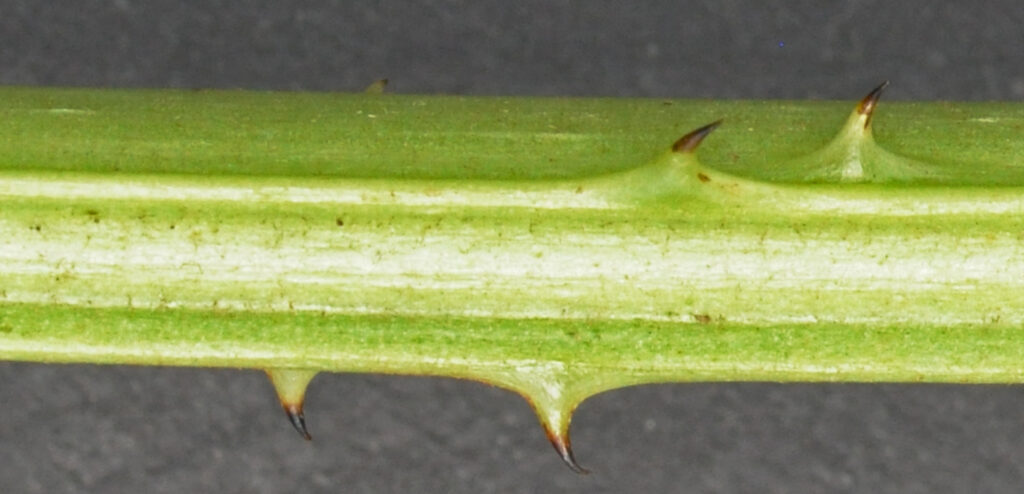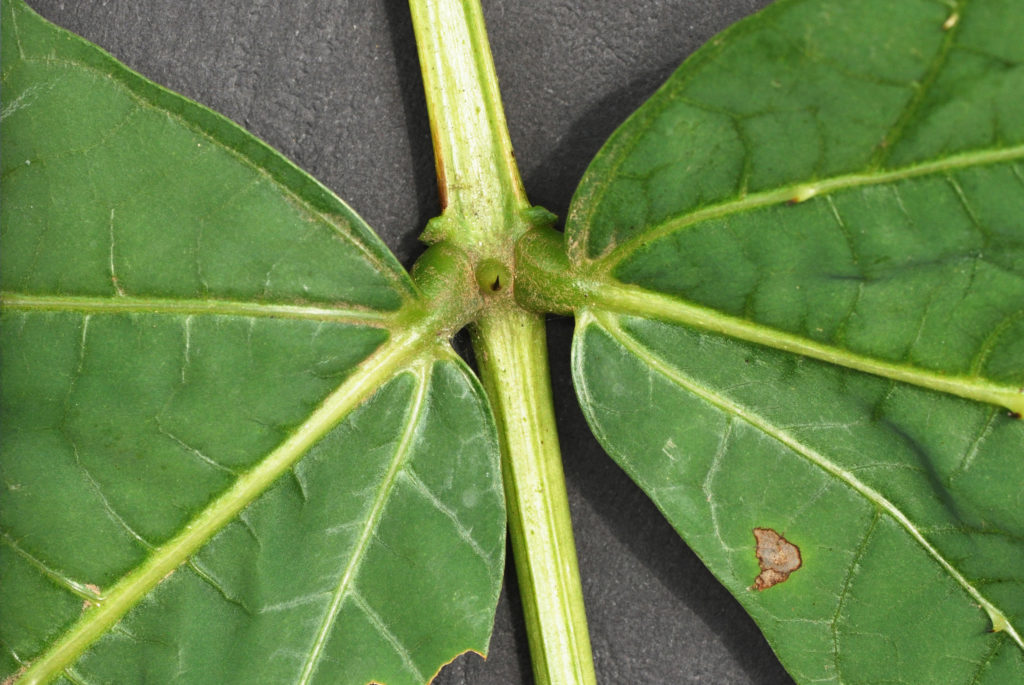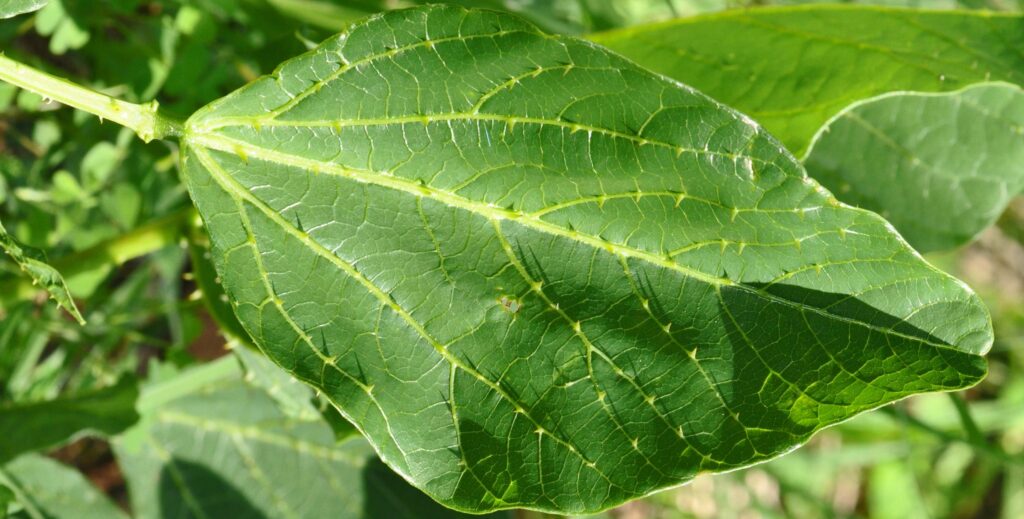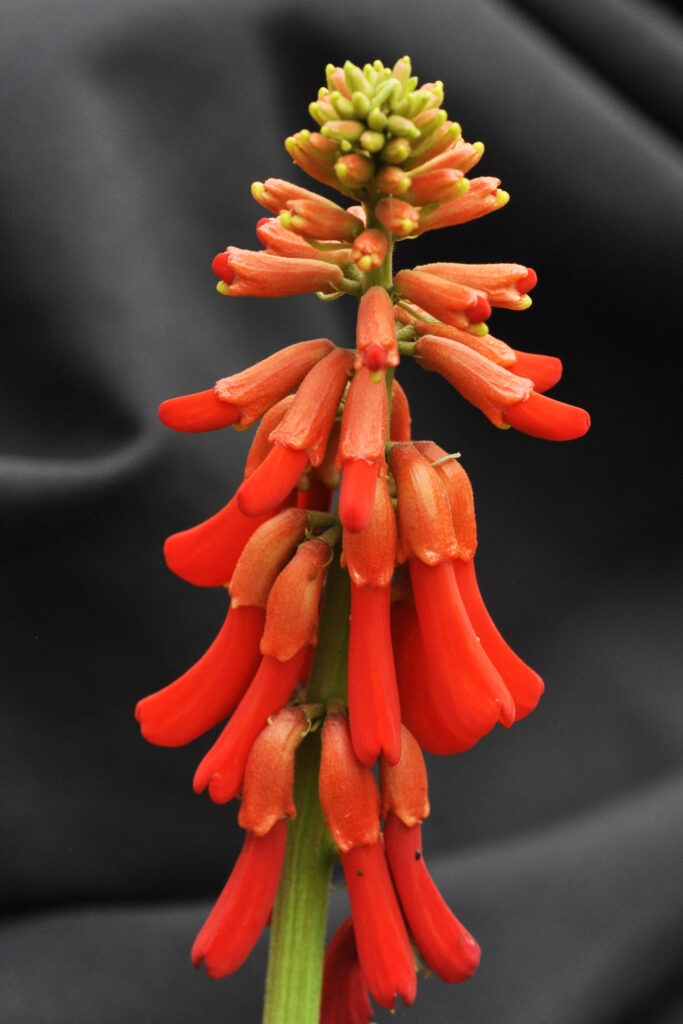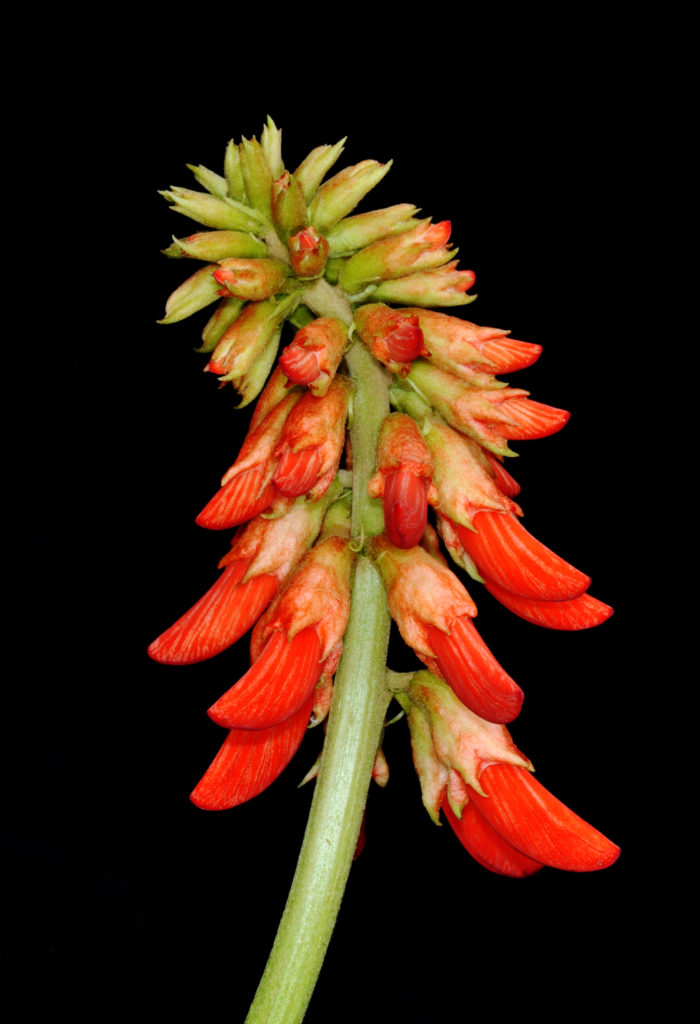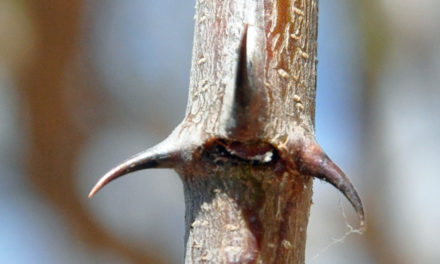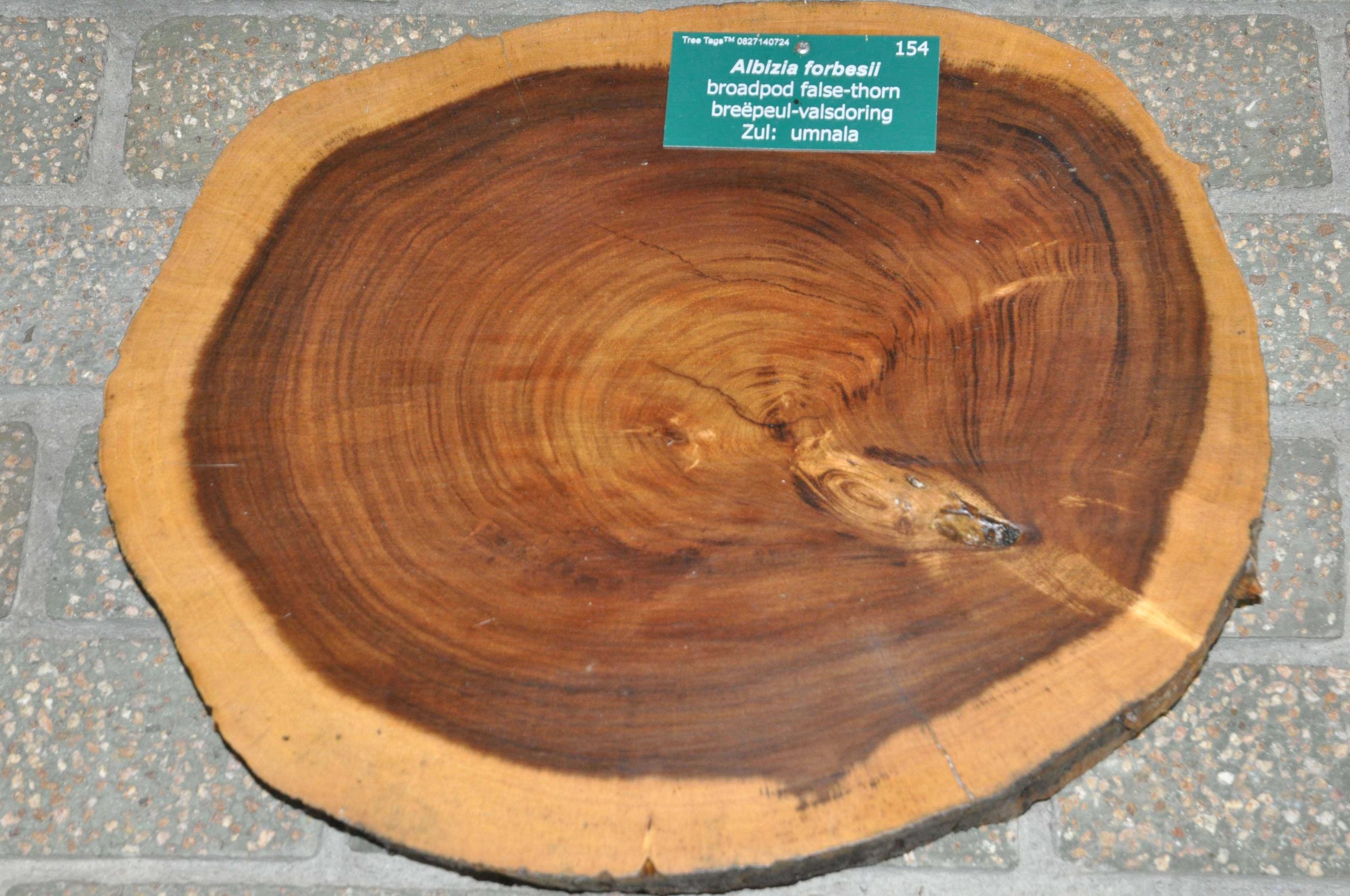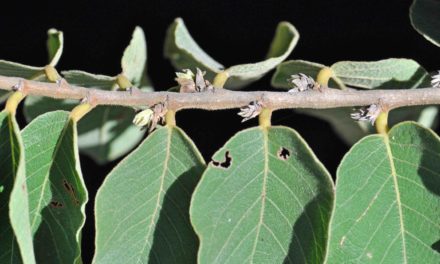General Info – summary
This Plant is suffrutescent and has most of its stem underground. The trunk is up to 60cm wide. The enormous, trifoliate Leaves have recurved spines on all veins on both leaf sides. The long petiolule is spiny. The impressive red Flowers are zygomorphic, bisexual and in racemes. The calyx becomes red and the vexillum surrounds the rest of the flower. Fruit is a cylindrical pod with about 5 reddish, hard seeds.
Description
Erythrina zeyheri.
Common names: (Afr) Kurkwortel, Ploegbreker, Tambukiwortel. (Eng) Plough breaker. (isiZulu) Umnsinsana. (Setswana) Khungoana, Motumo.
Family: Fabaceae, or Leguminosae (Pea, bean or legume family). After the Orchidaceae and the Asteraceae, the Fabaceae is the third largest Angiosperm (flowering plants) family with 700+ genera and close to 20 000 species. Local Tree genera on this website include Acacia (Vauchellia, Senegalia), Albizia, Bauhinia, Bolusanthus, Burkea, Calpurnia, Colophospermum, Cordyla, Cyclopia, Dichrostachys, Erythrina, Erythrophleum, Faidherbia, Indigofera, Mundulea, Peltophorum, Philenoptera, Piliostigma, Schotia and Xanthocercis. The Fabaceae are recognisable by their fruit and by their pinnately compound Leaves. Leaves may also be simple – even bilobed and usually have stipules – some of which may be spinescent. Leaflets are usually entire. Flowers are bisexual and bracteate. Regular flowers usually have 4-5 sepals and the same number of petals. Irregular flowers have 4-5 sepals and 5 or less petals. Stamens have anthers that have 2 pollen sacs and there are usually at least twice the number of stamens as petals – often 10. The superior Ovary has 1 locule containing 1 or more ovules. The Stigma and Style are simple. The single carpel develops into the Fruit, which is usually a pod. The fallen pods may break into segments. Seeds vary.
Name derivation: Erythrina from the Greek “erythros” meaning red. zeyheri named after Carl Ludwig Philipp Zeyher (1799-1858). He was a botanist and entomologist, who collected plants and insects in South Africa from about 1824. His adventures in South Africa are worth reading about.
Conservation: National Status: L C. (Least Concern). Assessment Date 2005. (W. Foden and L. Potter). However, the population is decreasing due to crop farming, urban development, garden and industrial waste deposits as well as coal mining.
Tree
The plant has been called an underground Tree and is Suffrutescent (subshrub/dwarf shrub or bush, is a short, usually a woody, perennial plant, with hibernating buds on persistent shoots near the ground). Most of this plant is underground – including most of the, up to 60cm wide, Trunk. The underground stem is exceptionally big and hard. It stores both water and food. Annual shoots form each year and may reach 0,5m long, and die back in winter.
Leaves
The light green, almost round and hairless Leaves are enormous for the genus Erythrina. They are up to at least 65cm long (Intro photo 903). Here the measuring device is up to 300mm long. The plant is deciduous and may become invisible during winter. The leaves are trifoliate (compound leaves with 3-leaflets – Intro photo 903). The Leaflets are up to 25 x 16cm. Like the Petiole (leaf stalk), the Midrib and Lateral veins are armed with Prickles. The prickles may become recurved, ending in dark brown to black sharp tips (photo 1003). Prickles occur on both surfaces including the Rachis (main axis bearing the leaflets –photo 01), main Veins and the Petiole. The Veins are more prominent on the lower side (photo 01). Three main veins arise from the base of each leaflet (photo 01). The Petiole (leaf stalk) is squarish (photos 01 and 1003) and up to at least 24cm long. Broad based Petiolules (stalks of leaflets) are all at least 6mm long (photo 01).
- 1003. 2015.01.27. Walter Sisulu NBG. Photo: David Becking.
- 01. 2015/01/27. Walter Sisulu NBG. Photo: David Becking.
- 276. 2014.12.02. Walter Sisulu NBG. Photo: David Becking.
Flowers
The bisexual and zygomorphic (the corolla is divisible into 2 equal halves in only one plane) Flowers are up to 9cm long. The almost upright Inflorescence develop together with the leaves in early summer in Raceme (simple, elongated, indeterminate inflorescence with stalked flowers – photo 289, that open in succession towards the apex – photo 399). The Calyx is joined to form a tube and its 5 short lobes have pointed ends (photo 289). These Sepals are initially green, turn reddish and cover the base of the petals of a mature flower. The Vexillum (the standard or banner petal) is the uppermost one of 5 Petals (photo 399). It is bright red or occasionally white. These standard petals are up to 7cm long and covers the other 4 petals (2 equal wing petals and the 2 joined keel petals at the base). The petals enclose the 10 Stamens (male reproductive part of a flower. Stamens produce Pollen in terminal anthers, each of which is supported by a Filament (a stalk). There is a single Pistil (a unit of the Gynoecium, the female element of the flower, composed of the Ovary, Style and Stigma). The stalked superior Ovary contains the ovules. There is a single incurved Style ending in a small Stigma (the part of the pistil that receives the pollen). Oct-Dec.
- 399. 2019/10/22. Walter Sisulu NBG. Photo: David Becking.
- 289. 2015/12/15 Walter Sisulu NBG. Photo: David Becking.
Fruit
The smooth, black, cylindrical Fruit is a Pod (usually a dry, dehiscent fruit) up to 20 x 2cm. Each Pod contains about 5 large Seeds (each up to 17mm long). They are smooth, hard, elliptic and orange to red.
Distribution & Ecology
This Plant appears in grasslands, deep sandy soils or with clay. The underground nature of this plant enables the plant to survive drought, fire and very cold conditions. It South Africa it grows in Northern Cape, KwaZulu-Natal, Free State, Gauteng, North West and Mpumalanga. This plough-breaker is also located in Lesotho and northwards to include Tanzania. Pollinating agents include insects and sunbirds.
Ethnobotany
Isoflavonoids (chemicals – with some health benefits) have been found in the Roots. The underground Stem is strong enough to damage ploughs (hence, the common name “plough breaker”). Do not eat the poisonous Seeds. Local people use them to make good-luck charms and for constructing necklaces. In order for seeds to germinate, they should be soaked in hot water before planting. This plant is slow growing and does best in summer rainfall environment. Removing the potentially enormous tuberous rootstock is not easy and are safest when growing well clear of buildings.
References
Coates Palgrave, M. 2002. Keith Coates Palgrave Trees of Southern Africa, edn 3. Struik, Cape Town.
Foden, W. & Potter, L. 2005. Erythrina zeyheri Harv. National Assessment: Red List of South African Plants version 2020.1. Accessed on 2023/05/06.
Lawrence, G. H. M, 1951. Taxonomy of Vascular Plants, The Macmillan Company, New York. Tenth Printing 1965.
Schmidt, S. Lotter, M. & McCleland, W. 2002. Trees and Shrubs of Mpumalanga and the Kruger National Park.
http://www.sciencedirect.com/science/article/pii/
http://www.plantzafrica.com/plantefg/erythrinzey.htm
http://www.operationwildflower.org.za/index.php/plant-records/trees/169-erythrina-zeyheri
http://posa.sanbi.org/flora/browse.php?src=SP
https://en.wikipedia.org/wiki/Karl_Ludwig_Philipp_Zeyher

